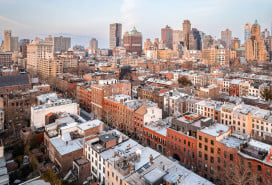3 questions you (and your lawyer) should ask before buying a NYC apartment in a post-Sandy world

As a real estate attorney representing NYC buyers and sellers, I can personally attest that Hurricane Sandy has not seemed to dim the appetite for co-ops and condos here, including in many areas that proved vulnerable to flooding.
Yet whether you believe Sandy was the storm of the century or merely the decade, it’s clear that in a post-Sandy world, buyers and their attorneys need to pay more attention to the potential risks and costs of buying an apartment in a flood-vulnerable area.
Here are some questions you and your attorney should be asking before you sign the contract to buy:
1. Was the building damaged by Sandy?
The mere fact that a building sustained damage—even severe damage—isn’t necessarily a reason not to buy. It is a reason for you and your lawyer to ask more questions, such as:
- If the building was damaged, has it been corrected—properly and by professionals? Has the Department of Buildings signed off on the repairs?
- Where and how was the building damaged? While home inspections aren’t traditionally performed by NYC buyers, you would be wise to hire an inspector to look over the affected areas as well as your prospective apartment.
- Was the damage covered by insurance and, if not, will residents face an assessment or maintenance/common charge increase down the road?
- Is the building addressing vulnerabilities to protect itself from future extreme weather events? How much will that cost and how much will residents be expected to pay?
- From a quality of life perspective, how well did the managing agent perform during Sandy? Were they prepared, organized, communicative? Your attorney may be able to glean some of this information from examination of the board minutes. An internet search of blogs and news articles may turn up more information.
2. Is the building located in a FEMA flood zone?
If the building is in a FEMA-designated flood zone, it must, as a practical matter, have flood insurance.
On top of that, if you are taking out a mortgage, your bank may also require you to purchase flood insurance on your apartment—even if you’re on the 15th floor. (If you do buy flood insurance, be sure to fully understand your coverage—both the maximum limits and things like temporary housing, which is rarely covered.)
It is important to keep in mind that much of the severe flooding during Hurricane Sandy occurred in areas outside FEMA’s 100-year-flood maps, which reportedly are in the process of being updated now. Has your prospective building experienced flooding or does it seem vulnerable? If so, does it have adequate insurance—or is future storm damage a cost that will be borne by residents? Even if you own an apartment on the 15th floor, for instance, you will have to pay your share of costs to fix damaged common elements, ranging from the basement gym to electrical and heating systems. It may be helpful to speak to someone in the insurance/risk management field to answer any insurance related questions.
3. Which evacuation zone is the building in?
The NYC Office of Emergency Management has divided low-lying and coastal areas into evacuation zones based on storm-surge threats.
Unlike FEMA flood zones, NYC’s evacuation zones carry no insurance consequences. It is up to you to determine how much it will matter to you if you must evacuate temporarily in the event of another big storm.
Real estate attorney Adam H. Stone, Esq., has been representing buyers and sellers of NYC property for over 15 years. He is a partner in the law firm Regosin, Edwards, Stone & Feder.


























